
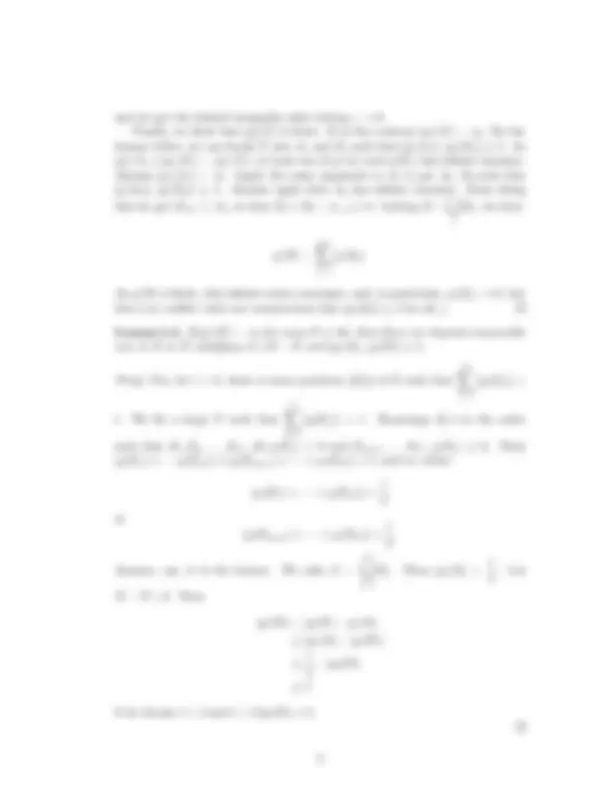
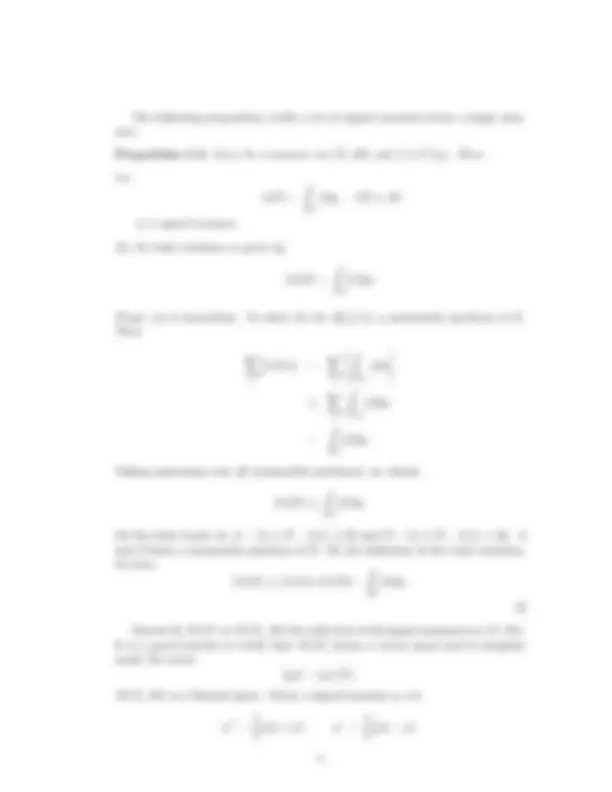
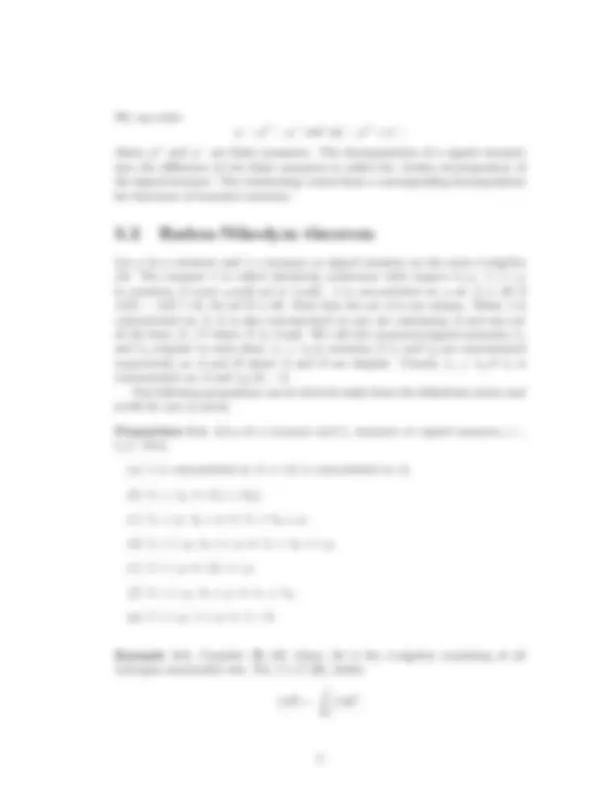
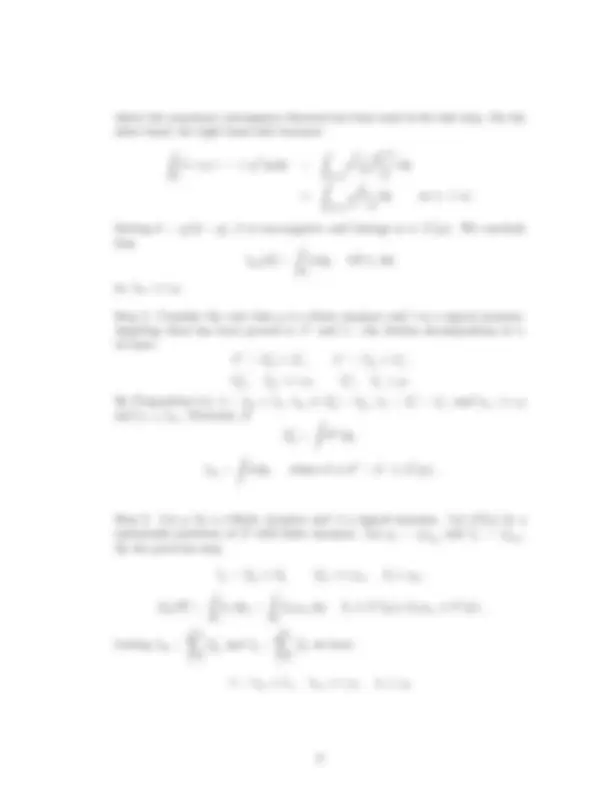
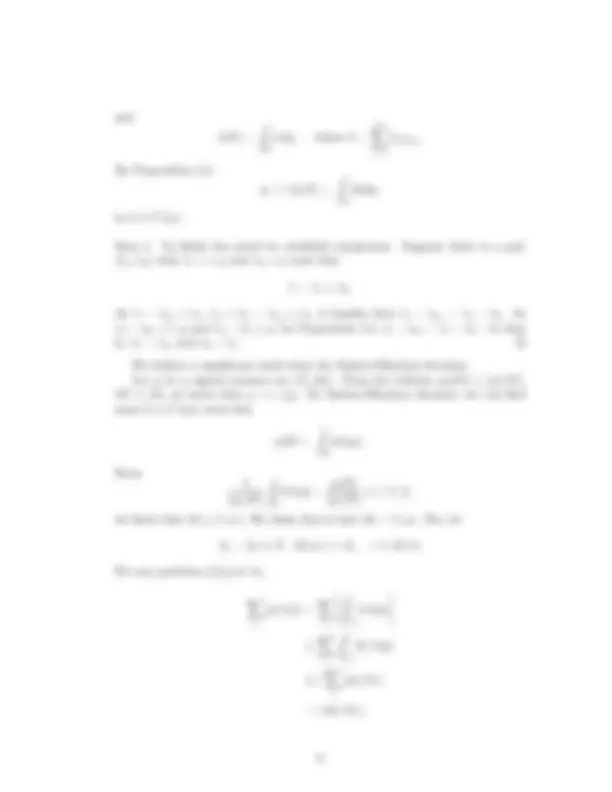
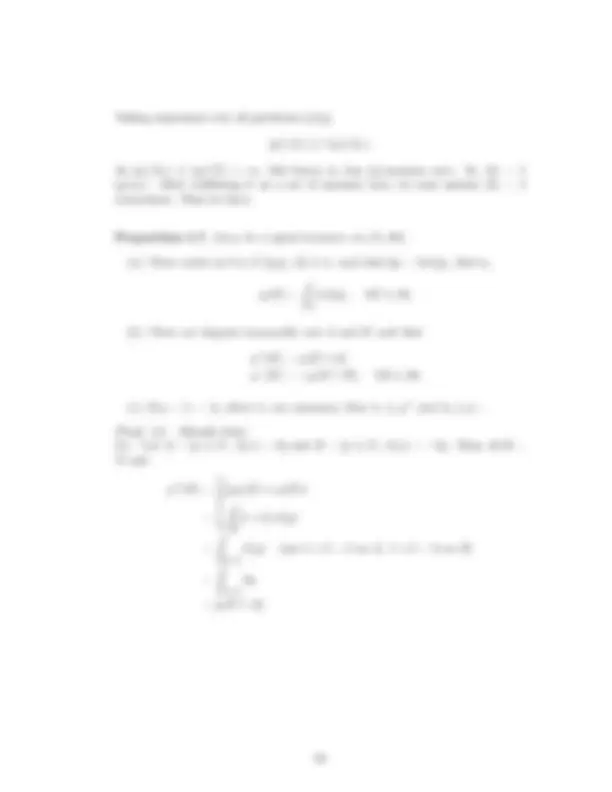
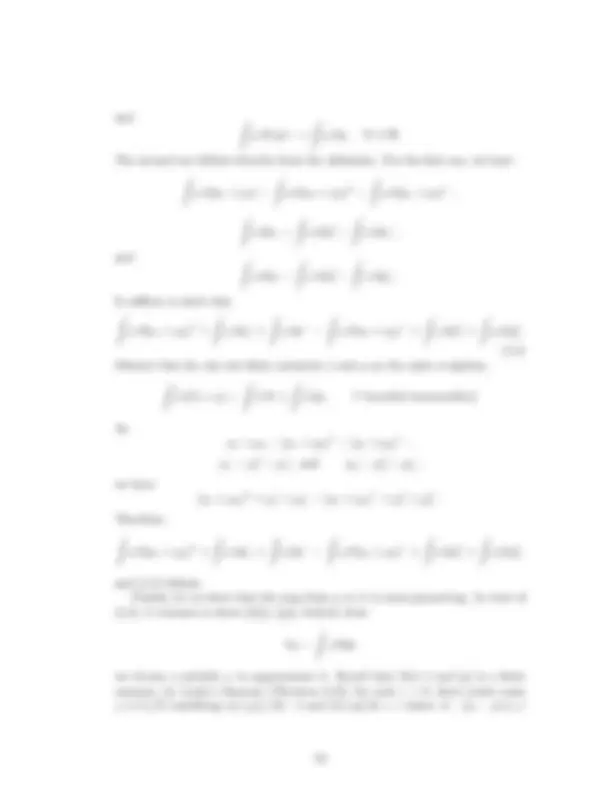
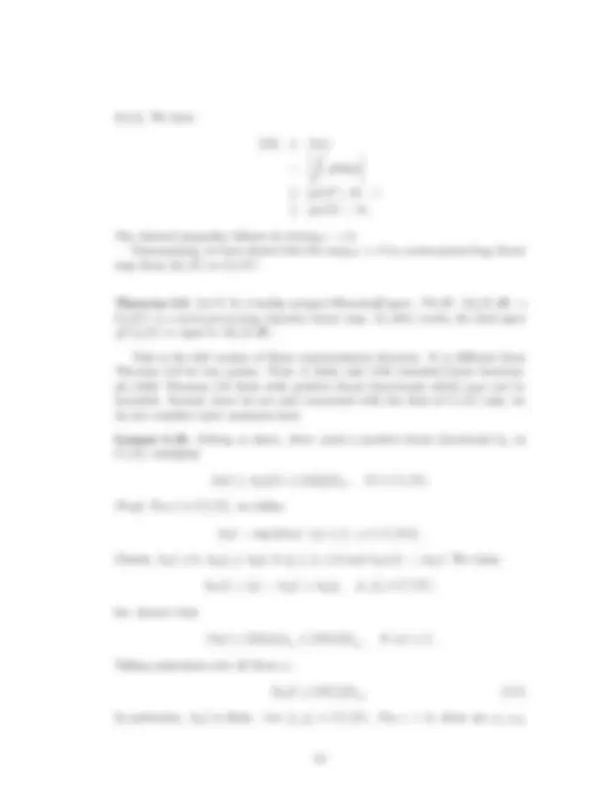
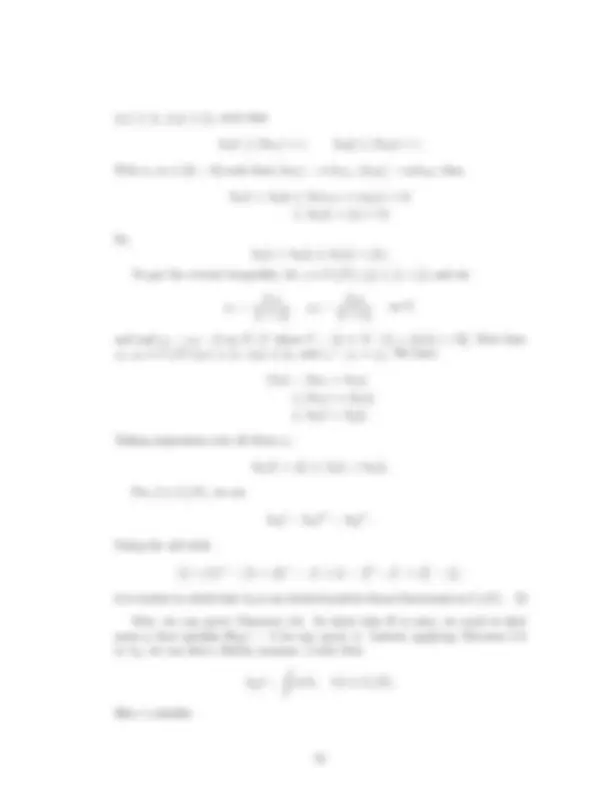
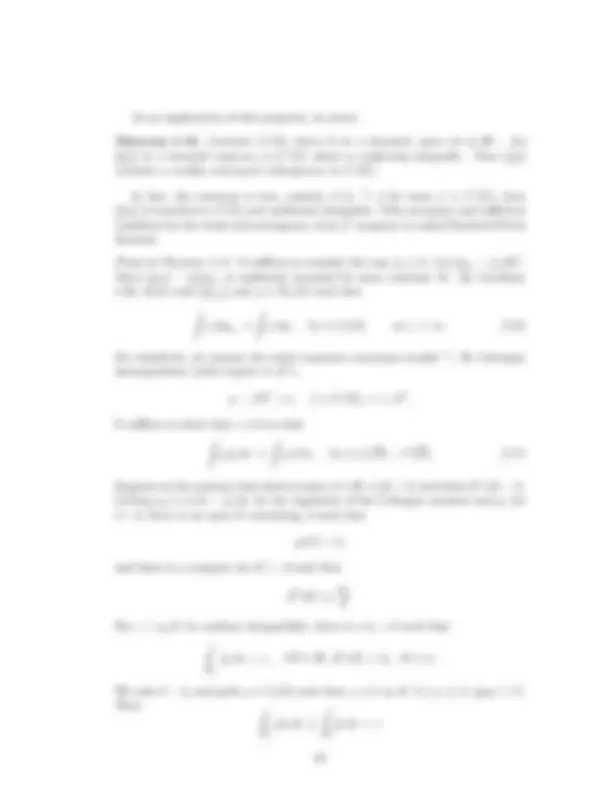
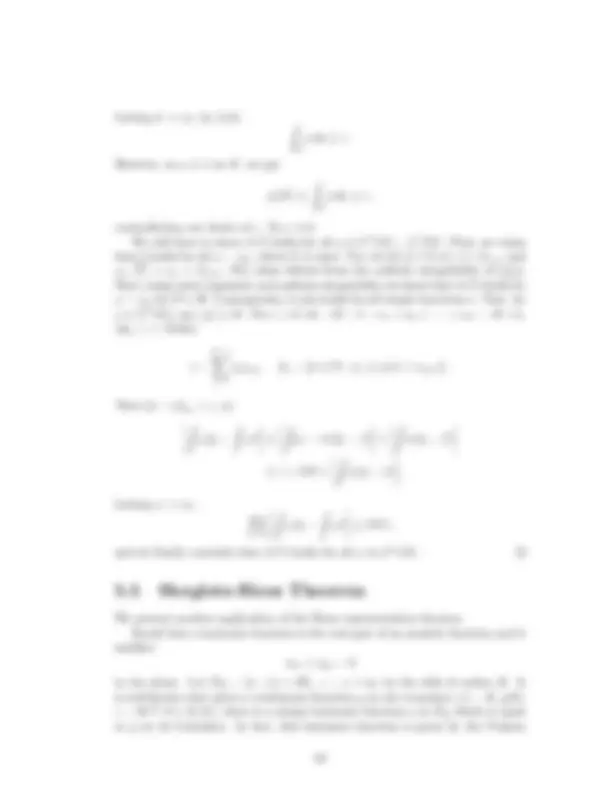
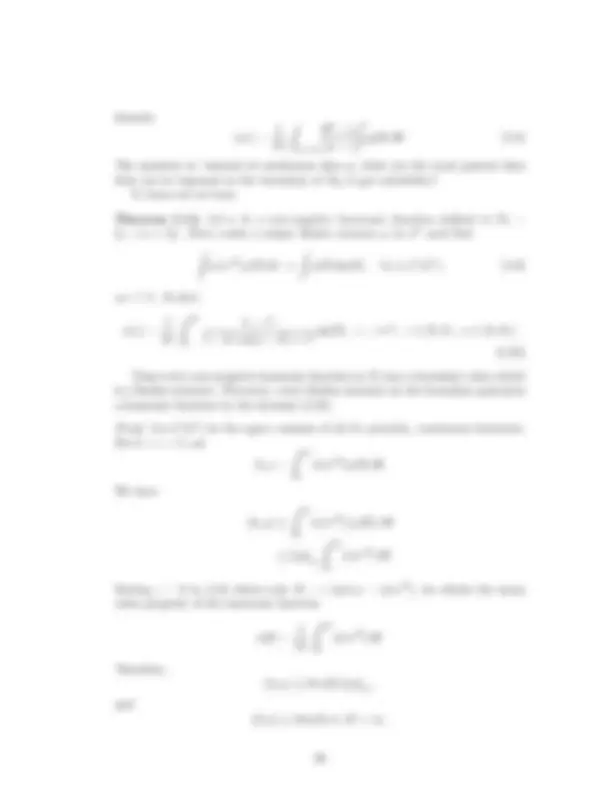
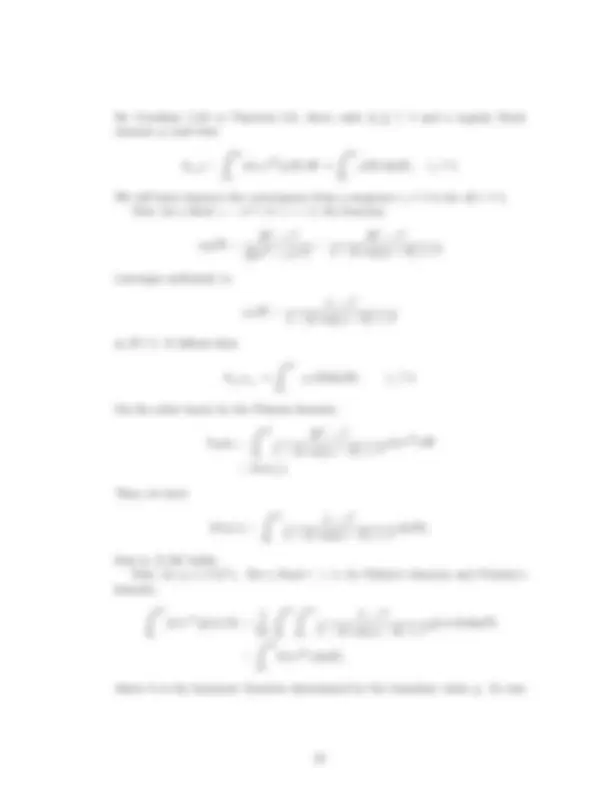
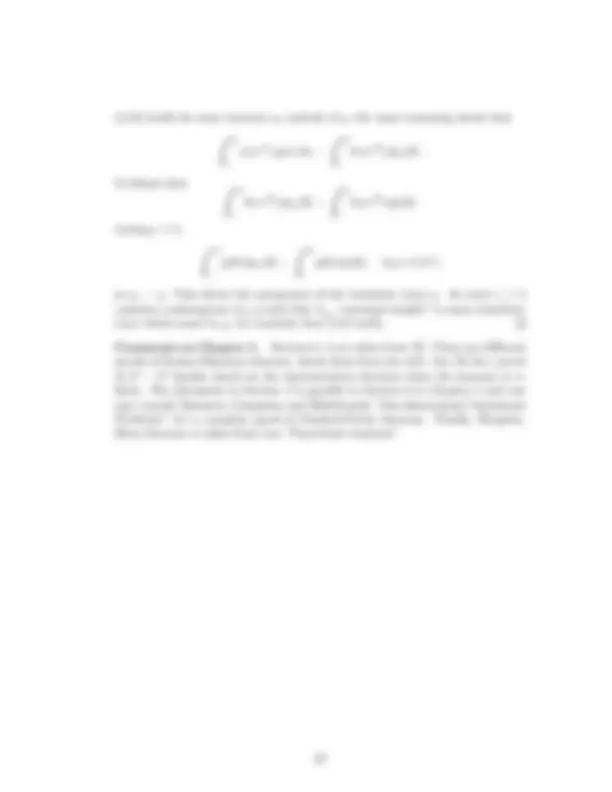


Study with the several resources on Docsity

Earn points by helping other students or get them with a premium plan


Prepare for your exams
Study with the several resources on Docsity

Earn points to download
Earn points by helping other students or get them with a premium plan
Community
Ask the community for help and clear up your study doubts
Discover the best universities in your country according to Docsity users
Free resources
Download our free guides on studying techniques, anxiety management strategies, and thesis advice from Docsity tutors
The Riesz representation theorem and its application to the Herglotz-Riesz theorem concerning the boundary trace of a non-negative harmonic function. signed measures, their total variation, subadditivity, and the Radon-Nikodym theorem. It also discusses the relationship between measures and signed measures, and the existence of unique pairs of signed measures that sum up to a given signed measure.
What you will learn
Typology: Study notes
1 / 22

This page cannot be seen from the preview
Don't miss anything!















Signed measures come up in at least two occasions. First, for any non-negative μ-measurable function f , the map E 7 →
E f dμ^ is a measure. When^ f^ changes sign, this map is still countably additive and it should be a “signed measure”. Second, in Theorem 2.8 it is shown that every positive linear functional on Cc(X) (X is a locally compact Hausdorff space) comes from a regular Borel measure. From the viewpoint of functional analysis, it is desirable to characterize the dual space of Cc(X) as the space of “signed measures”. We introduce signed measures in Section 1. Just like the absolute value of a function is non-negative, it is shown that the “ absolute value ” of a signed measure, its total variation, is a measure. In Section 2 we establish the important theorem of Radon-Nikodym and discuss how to decompose a measure or a signed measure into its absolute continuous and singular parts with respect to another measure. Then we use this theorem to establish the full Riesz representation theorem in Section 3. Weak∗^ convergence of sequences of signed measures is discussed in Section 4. As an application of the Riesz representation theorem we give a characterization of weakly convergent L^1 -sequences, part of the Dunford-Pettis theorem. Finally, as another application of the Riesz representation theorem, we prove Herglotz-Riesz theorem concerning the boundary trace of a non-negative harmonic function in Section 5.
Consider M a σ-algebra on the non-empty set X. A map μ : M → R is called a signed measure if it satisfies
μ(E) =
j=
μ(Ej ), ∀ partitions {Ej } of E.
Here {Ej } is called a (measurable) partition of E if they are mutually disjoint, measurable and E = ∪j Ej. One immediately deduces that μ(φ) = 0 and μ(X) is finite for a signed measure. The latter makes even a non-negative signed measure
different from a measure, namely it must be a finite measure. Given a signed measure on (X, M), its total variation (measure) is given by
|μ|(E) = sup{
j
|μ(Ej )|: ∀ partitions {Ej } of E.
Clearly |μ| (E 1 ) ≤ |μ| (E 2 ) if E 1 ⊂ E 2 , both in M.
Proposition 5.1. The total variation of every signed measure on (X, M) is a finite measure on (X, M).
Proof. We need to show
|μ| (E) =
j=
|μ| (Ej ),
whenever {Ej } is a partition of E. First we establish subaddivity. Let {Ak} be a partition of E. We have
∑
k
∣μ(Ak)
k
μ
Ak ∩
j
Ej
k
j
|μ(Ak ∩ Ej )|
j
k
|μ(Ak ∩ Ej )|
use
k
j
αkj =
j
k
αkj , ∀αkj ≥ 0
j
|μ| (Ej ).
{Ak ∩ Ej }k is a partition of Ej
Taking supremum over all {Ak},
|μ| (E) ≤
j
|μ| (Ej ).
Next, we show the reverse inequality. If |μ| (Ej ) = ∞ for some j, then |μ| (E) ≥ |μ| (Ej ) = ∞, the inequality holds. Let |μ| (Ej ) < ∞ ∀j. For ev- ery ε > 0, we can find a partition
Ekj
of Ej^ for each j such that
|μ| (Ej ) ≤
k
∣μ (Ej k
ε 2 j^
Now, {Ekj}k,j forms a partition of E. We have
∑
j
|μ| (Ej ) ≤
j
k
∣μ (Ej k
≤ |μ| (E) + ε
The following proposition yields a lot of signed measures from a single mea- sure.
Proposition 5.3. Let μ be a measure on (X, M) and f ∈ L^1 (μ). Then
(a)
λ(E) =
E
f dμ, ∀E ∈ M
is a signed measure.
(b) Its total variation is given by
|λ|(E) =
E
|f |dμ.
Proof. (a) is immediate. To show (b) let {Ej } be a measurable partition of E. Then
∑
j
|λ(Ej )| =
j
Ej
f dμ
j
Ej
|f |dμ
E
|f |dμ.
Taking supremum over all measurable partitions, we obtain
|λ|(E) ≤
E
|f |dμ.
On the other hand, let A = {x ∈ E : f (x) ≥ 0 } and B = {x ∈ E : f (x) < 0 }. A and B form a measurable partition of E. By the definition of the total variation, we have |λ|(E) ≥ |λ(A)|+|λ(B)|=
E
|f |dμ.
Denote by M (X) or M (X, M) the collection of all signed measures on (X, M). It is a good exercise to verify that M (X) forms a vector space and is complete under the norm ‖μ‖ = |μ| (X). M (X, M) is a Banach space. Given a signed measure μ, let
μ+^ =
(|μ| + μ), μ−^ =
(|μ| − μ).
We can write μ = μ+^ − μ−^ and |μ| = μ+^ + μ−,
where μ+^ and μ−^ are finite measures. The decomposition of a signed measure into the difference of two finite measures is called the Jordan decomposition of the signed measure. The terminology comes from a corresponding decomposition for functions of bounded variation.
Let μ be a measure and λ a measure or signed measure on the same σ-algebra M. The measure λ is called absolutely continuous with respect to μ, λ << μ in notation, if every μ-null set is λ-null. λ is concentrated on a set A ∈ M if λ(E) = λ(E ∩ A), for all E ∈ M. Note that the set A is not unique. When λ is concentrated on A, it is also concentrated on any set containing A and any set of the form A \ N where N is λ-null. We call two measures/signed measures λ 1 and λ 2 singular to each other, λ 1 ⊥ λ 2 in notation, if λ 1 and λ 2 are concentrated respectively on A and B where A and B are disjoint. Clearly, λ 1 ⊥ λ 2 if λ 1 is concentrated on A and λ 2 (A) = 0. The following proposition can be derived easily from the definitions above and is left for you to prove.
Proposition 5.4. Let μ be a measure and λi measures or signed measures, i = 1 , 2. Then
(a) λ is concentrated on A ⇒ |λ| is concentrated on A.
(b) λ 1 ⊥ λ 2 ⇒ |λ 1 | ⊥ |λ 2 |.
(c) λ 1 ⊥ μ, λ 2 ⊥ μ ⇒ λ 1 + λ 2 ⊥ μ.
(d) λ 1 << μ, λ 2 << μ ⇒ λ 1 + λ 2 << μ.
(e) λ << μ ⇒ |λ| << μ.
(f ) λ 1 << μ, λ 2 ⊥ μ ⇒ λ 1 ⊥ λ 2.
(g) λ << μ, λ ⊥ μ ⇒ λ = 0.
Example 5.1. Consider (R, M) where M is the σ-algebra consisting of all Lebesgue measurable sets. For f ∈ L^1 (R), define
ν(E) =
E
f dL^1.
so Λ is a bounded linear functional on L^2 (ρ). By the self-duality of L^2 (ρ), there exists some g ∈ L^2 (ρ) such that
∫ ϕ dλ =
ϕg dρ, ∀ϕ ∈ L^2 (ρ). (5.1)
Taking ϕ = χE , E ∈ M, ϕ belongs to L^2 (ρ) and we have
λ(E) =
E
g dρ,
and 1 ρ(E)
E
g dρ =
λ(E) ρ(E)
By a previous exercise, g ∈ [0, 1] ρ-a.e. By redefining g in a null set, we may assume g(X) ⊂ [0, 1]. Let λac(E) = λ(E ∩ A),
and λs(E) = λ(E ∩ B),
where A = {x ∈ X : g(x) ∈ [0, 1)} and B = {x ∈ X : g(x) = 1}. We have λ = λac + λs. We rewrite (5.1) as (^) ∫ ϕ(1 − g) dλ =
ϕg dμ. (5.2)
Taking ϕ = χB , we get
0 =
B
dμ = μ(B).
We conclude that λs ⊥ μ, since by definition λs is concentrated on B. Taking ϕ = χE (1 + g + · · · + gn) in (5.2), we have
∫ χE (1 − gn+1) dλ =
χE (1 + g + · · · + gn)g dμ.
The left hand side of this relation satisfies ∫ χE (1 − gn+1) dλ
E
(1 − gn+1) dλ
E∩A
(1 − gn+1) dλ
→ λ(E ∩ A) = λac(E), as n → ∞,
where the monotone convergence theorem has been used in the last step. On the other hand, the right hand side becomes
∫
E
(1 + g + · · · + gn)g dμ =
E∩A
g
1 − gn+ 1 − g
dμ
E∩A
g 1 − g
dμ as n → ∞.
Setting h = g/(1 − g), h is non-negative and belongs to ∈ L^1 (μ). We conclude that
λac(E) =
E
h dμ, ∀E ∈ M,
so, λac << μ.
Step 2. Consider the case that μ is a finite measure and λ is a signed measure. Applying what has been proved to λ+^ and λ−, the Jordan decomposition of λ, we have λ+^ = λ+ ac + λ+ s , λ−^ = λ− ac + λ− s , λ+ ac, λ− ac << μ, λ+ s , λ− s ⊥ μ.
By Proposition 5.4, λ = λac + λs, λac ≡ λ+ ac − λ− ac, λs = λ+ s − λ− s , and λac << μ and λs ⊥ λac. Moreover, if
λ± ac =
h±^ dμ,
λac =
h dμ, where h ≡ h+^ − h−^ ∈ L^1 (μ).
Step 3. Let μ be a σ-finite measure and λ a signed measure. Let {Xj } be a measurable partition of X with finite measure. Let μj = μbXj and λj = λbXj. By the previous step,
λj = λjac + λjs, λjac << μj , λjs ⊥ μj ,
λjac(E) =
E
hj dμj =
E
hj χXj dμ, hj ∈ L^1 (μj ), hj χXj ∈ L^1 (μ).
Letting λac =
j=
λjac and λs =
j=
λjs, we have
λ = λac + λs, λac << μ, λs ⊥ μ,
Taking supremum over all partitions {Aj },
|μ| (Ar) ≤ r |μ| (Ar).
As |μ| (Ar) ≤ |μ| (X) < ∞, this forces Ar has |μ|-measure zero. So, |h| = 1 |μ|-a.e. After redefining h on a set of measure zero, we may assume |h| = 1 everywhere. Thus we have
Proposition 5.7. Let μ be a signed measure on (X, M).
(a) There exists an h ∈ L^1 (|μ|), |h| ≡ 1 , such that dμ = h d |μ|, that is,
μ(E) =
E
h d |μ| , ∀E ∈ M.
(b) There are disjoint measurable sets A and B such that
μ+(E) = μ(E ∩ A) μ−(E) = −μ(E ∩ B), ∀E ∈ M.
(c) If μ = λ 1 − λ 2 where λi are measures, then λ 1 ≥ μ+^ and λ 2 ≥ μ−.
Proof. (a) Already done. (b) Let A = {x ∈ X : h(x) = 1} and B = {x ∈ X : h(x) = − 1 }. Then A ∪˙B = X and
μ+(E) =
(|μ| (E) + μ(E))
=
E
(1 + h) d |μ|
E∩A
d |μ| (use 1 + h = 2 on A, 1 + h = 0 on B)
E∩A
dμ
= μ(E ∩ A).
Similarly,
μ−(E) =
(|μ| (E) − μ(E))
=
E
(1 − h) d |μ|
E∩B
d |μ|
E∩B
dμ
= −μ(E ∩ B).
(c) As μ = λ 1 − λ 2 ≤ λ 1 ,
μ+(E) = μ(E ∩ A) ≤ λ 1 (E ∩ A) ≤ λ 1 (E).
As −μ = λ 2 − λ 1 ≤ λ 2 ,
μ−(E) = −μ(E ∩ B) ≤ λ 2 (E ∩ B) ≤ λ 2 (E).
The existence of disjoint A and B such that μ+^ = μbA and μ−^ = μbB is called the Hahn decomposition of μ. Proposition 5.6(c) shows certain minimal property of the decomposition.
The space Cc(X) may not be complete under the supnorm. For instance, the function e−x 2 is the uniform limit of a sequence of functions in Cc(R), but it is positive everywhere. The space of all bounded, continuous functions on a topological space forms a Banach space where Cc(X) is its subspace. We denote the closure of Cc(X) in in this space by C 0 (X). It is a Banach space. In fact, when X is a locally compact Hausdorff space, one can show that it consists of all continuous functions that vanish at infinity. More precisely, f belongs to C 0 (X) if and only if, for every ε > 0, there is a compact set K such that |f | is less than ε outside K. Of course, C 0 (X) is equal to Cc(X) when X is compact. As Cc(X) is dense in C 0 (X), the dual space of Cc(X) can be identified with the dual space of C 0 (X). From now on we take X to be a locally compact Hausdorff topological space. A signed measure μ ∈ M (X) = M (X, B) is called regular if every E ∈ B is inner
and (^) ∫
ϕ d(cμ) = c
ϕ dμ, ∀c ∈ R.
The second one follows directly from the definition. For the first one, we have ∫ ϕ d(μ 1 + μ 2 ) =
ϕ d(μ 1 + μ 2 )+^ −
ϕ d(μ 1 + μ 2 )−^ ,
∫ ϕ dμ 1 =
ϕ dμ+ 1 −
ϕ dμ− 1 ,
and (^) ∫
ϕ dμ 2 =
ϕ dμ+ 2 −
ϕ dμ− 2.
It suffices to show that ∫ ϕ d(μ 1 + μ 2 )+^ +
ϕ dμ− 1 +
ϕ dμ−^ =
ϕ d(μ 1 + μ 2 )−^ +
ϕ dμ+ 1 +
ϕ dμ+ 2. (5.4) Observe that for any two finite measures λ and μ on the same σ-algebra, ∫ f d(λ + μ) =
f dλ +
f dμ, ∀ bounded measurablef,
As μ 1 + μ 2 = (μ 1 + μ 2 )+^ − (μ 1 + μ 2 )−^ , μ 1 = μ+ 1 − μ− 1 , and μ 2 = μ+ 2 − μ− 2 ,
we have (μ 1 + μ 2 )+^ + μ− 1 + μ− 2 = (μ 1 + μ 2 )−^ + μ+ 1 + μ+ 2.
Therefore, ∫ ϕ d(μ 1 + μ 2 )+^ +
ϕ dμ− 1 +
ϕ dμ−^ =
ϕ d(μ 1 + μ 2 )−^ +
ϕ dμ+ 1 +
ϕ dμ+ 2 ,
and (5.4) follows. Finally, let us show that the map from μ to Λ is norm-preserving. In view of (5.3), it remains to show ‖Λ‖≥ ‖μ‖. Indeed, from
Λϕ =
ϕhdμ
we choose a suitable ϕ to approximate h. Recall that |h|≡ 1 and |μ| is a finite measure, by Lusin’s theorem (Theorem 2.12), for each ε > 0, there exists some ϕ ∈ Cc(X) satisfying (a) |ϕ|≤ |h|= 1 and (b) |μ|(A) < ε where A = {x : ϕ(x) 6 =
h(x)}. We have
‖Λ‖ ≥ |Λϕ|
=
ϕhd|μ|
≥ |μ|(X \ A) − ε ≥ |μ|(X) − 2 ε.
The desired inequality follows by letting ε → 0. Summarizing, we have shown that the map μ 7 → Λ is a norm-preserving, linear map from Mr(X) to C 0 (X)′.
Theorem 5.9. Let X be a locally compact Hausdorff space. The Φ : Mr(X, B) → C 0 (X)′^ is a norm-preserving, bijective linear map. In other words, the dual space of C 0 (X) is equal to Mr(X, B).
This is the full version of Riesz representation theorem. It is different from Theorem 2.8 for two points. First, it deals only with bounded linear function- als while Theorem 2.8 deals with positive linear functionals which may not be bounded. Second, since we are only concerned with the dual of Cc(X) only, we do not consider outer measures here.
Lemma 5.10. Setting as above, there exists a positive linear functional Λ 0 on Cc(X) satisfying
|Λf | ≤ Λ 0 (|f |) ≤ ‖Λ‖‖f ‖∞, ∀f ∈ Cc(X).
Proof. For f ∈ C c+ (X), we define
Λ 0 f = sup {|Λϕ| : |ϕ| ≤ f, ϕ ∈ Cc(X)}.
Clearly, Λ 0 f ≥ 0, Λ 0 f 2 ≥ Λ 0 f 1 if f 2 ≥ f 1 ≥ 0 and Λ 0 (cf ) = cΛ 0 f. We claim
Λ 0 (f 1 + f 2 ) = Λ 0 f 1 + Λ 0 f 2 , f 1 , f 2 ∈ C c+ (X).
for, observe that
|Λϕ| ≤ ‖Λ‖ ‖ϕ‖∞ ≤ ‖Λ‖ ‖f ‖∞ , if |ϕ| ≤ f.
Taking supremum over all these ϕ,
|Λ 0 f | ≤ ‖Λ‖ ‖f ‖∞. (5.5)
In particular, Λ 0 f is finite. Let f 1 , f 2 ∈ C+ c (X). For ε > 0, there are ϕ 1 , ϕ 2 ,
By Lemma 5.10, ∣ ∣ ∣ ∣
f dλ
∣ =^ |Λ^0 f^ | ≤ ‖Λ‖ ‖f^ ‖∞ ,^ ∀f^ ∈^ Cc(X).
From the proof of Theorem 2.8,
λ(X) = sup {|Λ 0 f | : 0 ≤ f ≤ 1 on X}.
In view of this, we have λ(X) ≤ ‖Λ‖ ,
i.e., λ belongs to Mr(X). From the definition of Λ 0 we also have
|Λf | ≤ Λ 0 f +^ + Λ 0 f − = ‖f ‖L (^1) (λ), ∀f ∈ Cc(X).
As Cc(X) is dense in L^1 (λ), Λ can be extended to a bounded linear functional on L^1 (λ). Since λ is a finite measure, by L^1 - L∞^ duality there exists some h ∈ L∞(λ) such that
Λf =
f h dλ ∀f ∈ L^1 (λ),
and the operator norm of Λ as a linear functional on L^1 (λ) is equal to ‖h‖∞. Using |Λf |≤ ‖f ‖L^1 (λ), we have ‖h‖∞≤ 1. On the other hand, we have
‖Λ‖ = sup{|Λϕ|: ϕ ∈ Cc(X), |ϕ|≤ 1 }
≤
|h|dλ
≤ λ(X) ≤ ‖Λ‖,
which forces |h|= 1 λ-a.e. and λ(X) = ‖Λ‖. Now we set
μ(E) =
E
hdλ, ∀E ∈ B.
By Proposition 5.8, μ ∈ Mr(X). By Proposition 5.3, |μ|= λ and so ‖μ‖= ‖Λ‖. We conclude that Φ is a norm-preserving linear bijection from Mr(X, B) to C 0 (X)′. The proof of Theorem 5.9 is completed.
Let E be a normed space and E′^ its dual space. A sequence {Λk} ⊂ E′^ is called weakly∗^ convergent to Λ ∈ E′^ if
Λkx → Λx, ∀x ∈ E,
as k → ∞. Consider Lp(μ), 1 < p < ∞, we know that Lp(μ) = Lq(μ)′^ where q is
conjugate to p. For fk ∈ Lp, fk ∗ ⇀ f if and only if ∫ fkg dμ →
f g dμ, ∀g ∈ Lq(μ).
This turns out to be the same as fn ⇀ f. So when 1 < p < ∞, weak∗^ and weak convergence are the same, depending on whether to regard Lp(μ) as the “base” space or the dual of Lq(μ). Applying to the case the space C 0 (X) where X is a locally compact Hausdorff space, by the representation theorem
μn ⇀ μ^ ∗ in Mr(X)
if and only if (^) ∫
ϕ dμn →
ϕ dμ, ∀ϕ ∈ Cc(X).
The following result is sometimes called Helly selection theorem.
Theorem 5.11. Let E be a separable normed space. Every bounded sequence in E′^ contains a weakly∗^ convergent subsequence.
This theorem can be proved as Theorem 5.8 and we omitted its proof. As a special case we have
Corollary 5.12. Let C 0 (X) be separable. Every sequence {μk} in Mr(X), ‖μk‖ ≤
M for some M , contains a subsequence μkj which μkj ∗ ⇀ μ for some μ ∈ Mr(X).
One can show that the space C 0 (X) is separable when X is a compact metric space or it is an open set in Rn. Recall that even ‖fk‖L 1 is uniformly bounded, we cannot always pick a weakly convergent subsequence fnj in L^1 (μ). As a typical example we may take {fk} satisfying sptfk = [ak, bk] shrinks to {x 0 } and ‖fk‖L^1 = 1 for all k. Then no subsequence of fk converges weakly. However, if we regard an L^1 -function as a measure by setting dμk = fk dL^1 , μk now belongs to the larger space Mr(R) and ‖μk‖ = ‖fk‖L 1 = 1. By Corollary 5.10, it has weak∗^ subconvergence μkj ∗ ⇀ μ. In fact, it is clear that the entire sequence converges weakly∗^ to the Dirac measure δx 0. The lesson is, by enlarging the space from L^1 (R) to Mr(R), we get subconvergence.
Letting k → ∞, by (5.6) (^) ∫
G
ϕ dμ ≤ ε.
However, as ϕ ≡ 1 on K, we get
μ(K) ≤
G
ϕ dμ ≤ ε,
contradicting our choice of ε. So ν ≡ 0. We still have to show (5.7) holds for all ϕ ∈ L∞(Ω) = L^1 (Ω)′. First, we claim that it holds for all ϕ = χG, where G is open. For, let {Gj } ↑ G, Gj ⊂⊂ Gj+1 and ϕj , Gj < ϕj < Gj+1. The claim follows from the uniform integrability of {fk}. Next, using outer regularity and uniform integrability we know that (5.7) holds for ϕ = χE for E ∈ B. Consequently, it also holds for all simple functions s. Now, let ϕ ∈ L∞(Ω), say, |ϕ| ≤ M. For ε > 0, let −M − 1 = a 1 < a 2 < · · · < aN = M + 1, ∆aj < ε. Define
s =
j=
aj χAj , Aj = {x ∈ Ω : aj ≤ ϕ(x) < aj+1}.
Then ‖s − ϕ‖∞ < ε, so
∣ ∣ ∣ ∣
ϕfk −
ϕf
(ϕ − s)(fk − f )
s(fk − f )
≤ ε × 2 M +
s(fk − f )
Letting n → ∞,
lim k→∞
ϕfk −
ϕf
∣ ≤^2 M ε,
and we finally conclude that (5.7) holds for all ϕ in L∞(Ω).
We present another application of the Riesz representation theorem. Recall that a harmonic function is the real part of an analytic function and it satisfies uxx + uyy = 0
in the plane. Let DR = {z : |z| < R}, z = x + iy, be the disk of radius R. It is well-known that given a continuous function g on the boundary |z| = R, g(θ), z = Reiθ, θ ∈ [0, 2 π], there is a unique harmonic function u in DR which is equal to g on its boundary. In fact, this harmonic function is given by the Poisson
formula
u(z) =
2 π
|w|=R
R^2 − |z|^2 |w − z|^2
g(θ) dθ. (5.8)
The question is: Instead of continuous data g, what are the most general data that can be imposed on the boundary of DR to get solvability? It turns out we have
Theorem 5.14. Let u be a non-negative harmonic function defined in D 1 = {z : |z| < 1 }. There exists a unique Radon measure μ on S^1 such that
∫ u(reiθ)ϕ(θ) dx →
ϕ(θ) dμ(θ), ∀ϕ ∈ C(S^1 ), (5.9)
as r ↑ 1. In fact,
u(z) =
2 π
∫ (^2) π
0
1 − r^2 1 − 2 r cos(α − θ) + r^2
dμ(θ), z = reiα, r ∈ (0, 1), α ∈ [0, 2 π].
(5.10)
Thus every non-negative harmonic function in D 1 has a boundary value which is a Radon measure. Moreover, every Radon measure on the boundary generates a harmonic function by the formula (5.10).
Proof. Let C(S^1 ) be the space consists of all 2π–periodic, continuous functions. For 0 < r < 1, set
Λrϕ =
∫ (^2) π
0
u(reiθ)ϕ(θ) dθ.
We have
|Λrϕ| ≤
∫ (^2) π
0
u(reiθ) |ϕ(θ)| dθ
≤ ‖ϕ‖∞
∫ (^2) π
0
u(reiθ) dθ.
Setting z = 0 in (5.8) where now R = r and g = u(reiθ), we obtain the mean value property of the harmonic function
u(0) =
2 π
∫ (^2) π
0
u(reiθ) dθ.
Therefore, |Λrϕ| ≤ 2 πu(0) ‖ϕ‖∞ ,
and ‖Λr‖ ≤ 2 πu(0) ≡ M < ∞.